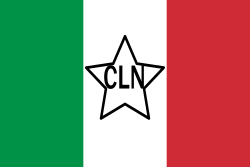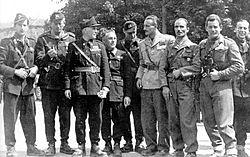Italian resistance movement facts for kids
Quick facts for kids Italian resistance movement |
|
|---|---|
| Participant in the Italian Civil War and World War II | |
 
Flag of the National Liberation Committee and some members of the Italian resistance in Ossola, 1944.
|
|
| Active | Most active 1943–1945; the Resistance originated following the rise of Fascist Italy in the 1920s |
| Ideology | Various: Generally anti-fascism Mainly various forms of communism, socialism, and anarchism; Republicanism and liberalism< To a lesser extent: Liberal socialism Christian democracy Catholic anti-fascism / Catholic anti-Nazism Catholic socialism Social liberalism Social democracy Monarchism |
| Allies | |
| Opponents | Axis powers (Fascist Italy, Nazi Germany and Italian Social Republic) |
The Italian resistance movement (called Resistenza italiana or just la Resistenza in Italian) was a group of brave people in Italy who fought during World War II. They stood up against the forces of Nazi Germany and the Italian Social Republic from September 1943 to April 1945.
These fighters were known as partisans (partigiani in Italian). The difficult conflict they were part of is often called the Italian Liberation War. They played a big role in freeing Italy from foreign control and the Fascist government.
Contents
What Was the Italian Resistance?
The Italian resistance movement was made up of many different groups. These groups had one main goal: to fight against the Axis powers in Italy. The Axis powers included Nazi Germany and the Italian Social Republic. The Italian Social Republic was a government set up by Benito Mussolini in northern Italy. It was supported by Nazi Germany.
The resistance began to grow after Italy signed an armistice (a peace agreement) with the Allies in September 1943. Before this, Italy had been an ally of Germany. After the armistice, German forces quickly took control of much of Italy. This led many Italians to form secret groups and fight back.
Who Were the Partisans?
The people who joined the resistance were called partisans. They came from all walks of life. There were students, farmers, factory workers, and even former soldiers. They had different political ideas, but they all shared a desire for a free Italy.
Some partisans believed in communism or socialism. Others were republicans or liberals. There were also Christian democrats and people who supported the monarchy. Despite their differences, they worked together to fight for their country's freedom.
Why Did They Fight?
The partisans fought for several important reasons:
- To free Italy: They wanted to remove German occupation from their country.
- Against Fascism: They opposed the Fascist government led by Mussolini. They wanted Italy to be a democracy.
- For justice: They fought against the violence and oppression of the Nazi and Fascist regimes.
Their actions helped weaken the enemy forces. They also helped the Allied armies as they advanced through Italy.
How the Resistance Fought
The partisans used many different tactics to fight:
- Guerrilla warfare: They carried out surprise attacks on German and Fascist troops. They would hit quickly and then disappear.
- Sabotage: They destroyed enemy supplies, communication lines, and transportation. This made it harder for the enemy to move troops and equipment.
- Intelligence gathering: They collected information about enemy movements and shared it with the Allies.
- Rescuing people: They helped Allied prisoners of war escape. They also protected Jewish people and others who were being persecuted.
The resistance movement was very dangerous. Partisans faced harsh punishments if caught. Many were captured, tortured, or killed. Despite the risks, they continued their fight.
The Italian Liberation War
The period from September 1943 to April 1945 is known as the Italian Liberation War. During this time, the partisans fought alongside the Allied forces. They helped liberate many towns and cities before the Allies arrived.
One important event was the general uprising in April 1945. The National Liberation Committee (CLN), which led the resistance, called for a nationwide revolt. This uprising helped to push the remaining German and Fascist forces out of Italy. April 25th, the day of the uprising, is now celebrated as Liberation Day in Italy. It is a national holiday.
Legacy of the Resistance
The Italian resistance movement played a crucial role in the end of World War II in Italy. Their bravery and sacrifice helped bring about the liberation of their country. The resistance also helped lay the groundwork for the new Italian Republic. After the war, Italy became a democracy, moving away from its Fascist past.
The memory of the partisans is still very important in Italy today. They are remembered as heroes who fought for freedom and justice.
Images for kids
-
Partisan monument (Arcevia) with Italian and Yugoslav names
-
A woman executed by public hanging in a street of Rome, early 1944
-
German soldier examining the papers of an Italian civilian outside of Milan (1944)
See also
 In Spanish: Resistencia italiana para niños
In Spanish: Resistencia italiana para niños






